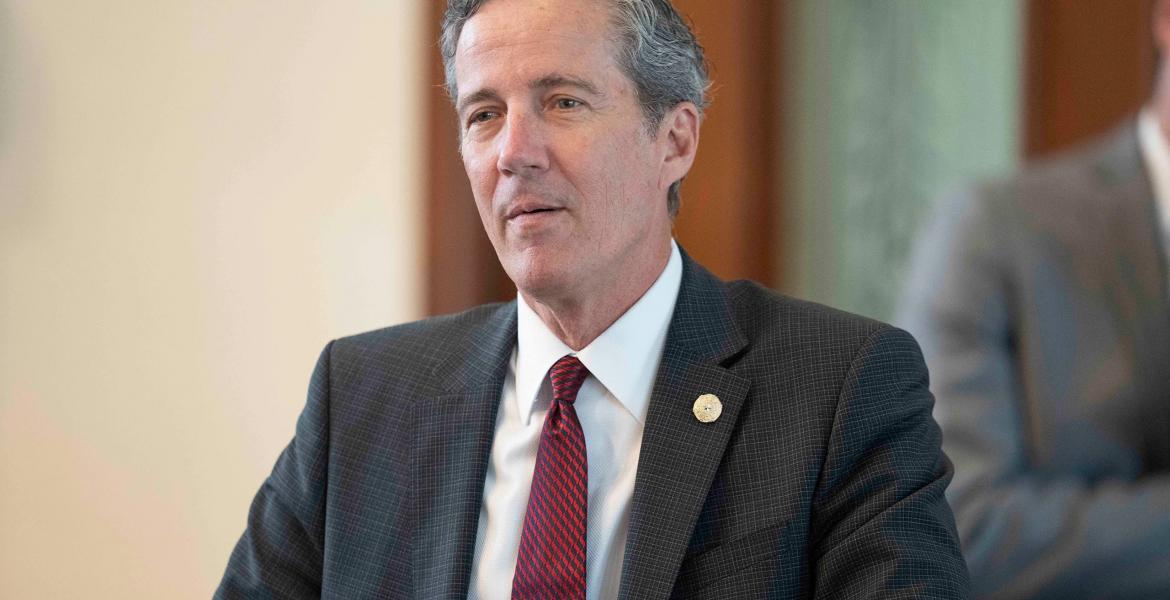“Don’t look through the keyhole or der Weihnachtsmann (Santa Claus) will take everything back,” says Laverne Boos, recalling the words of her father in fluent German.
The keyhole belonged to a locked living room door, and behind it, her father and mother worked every Christmas Eve to set up and decorate the tree.
Once the tree was decorated, the children were allowed to enter, where colorfully-wrapped Christmas presents waited to be opened that very night.
The tradition is telling of Boos’ heritage, and although most Germans will tell you that Santa Claus is the invention of Coca Cola—das Christkind (the child Christ) appears with gifts in Europe—the timeline of the Christmas tree decorating and Bescherung (opening gifts) is congruent with the traditions maintained overseas.
“I think especially those of us who have been here, we still carry on our traditions,” Boos said, standing in the lobby of the Fredericksburg Pioneer Museum, “and I think some of the other families are starting to pick them up, too.”
For 168 years the interpreter’s family has been living in the area just two and a half hours southeast of San Angelo, German immigrants who came by sea via the Gulf of Mexico in 1846.
Each holiday season in the Texas-German town starts with the first Advent, and continues with Nikolaustag on Dec. 6, where children place boots outside their doors or hang up stockings in the hopes of receiving treats like oranges, nuts and chocolates in exchange for being good all year.
In a variation of the age-old tradition, Boos said she and her family hung stockings from their bedposts, the predecessor to the American tradition of stockings dangling from the fireplace mantel.
Christmas and Easter are the two biggest holidays in the town nestled in the Texas Hill Country, holidays steeped in the city’s German heritage that in many ways emulate the celebrations held overseas.
And while public festivals, events and placards bearing the German words “Willkommen” and “Biergarten” give a sense of the city’s history, the real cultural experience often takes place behind the doors of Fredericksburg natives who have passed down traditions over a century and a half.
Feiertage
A large wooden pyramid stands in the grass of the Marktplatz, with five graduated tiers adorned with candles, wooden choir singers, angels and nutcrackers building up to horizontal propellers that turn at the top.
Standing at a total of 26 feet tall, the Weihnachtspyramide (Christmas pyramid) is the only one of its kind in the U.S. and was shipped over from Germany piece-by-piece roughly nine years ago.
Irene Merz, a fourth-generation native of Fredericksburg and Docent at the town’s Vereinskirche (community church), recalls having smaller Christmas pyramids set up in her home every year when her mother was still alive.

In the absence of a Christmas market, Fredericksburg’s pyramid stands among a community Christmas tree and the Vereinskirche, for tourists an interesting windmill-type thing, for natives a well-known Christmas symbol that brings home was typisch deutsches (something typically German).
“At Christmastime, we still sing some of the German Christmas songs…We still do our old-fashioned things. We have zweite Weihnachten. We still do that here. Most of the time we don’t take the Christmas tree down until the 6th of January,” Merz said. “When mother was still alive, we would have [an Adventskranz] (Advent wreath) and we would have the pyramid with the angels. We do St. Nick, too on Dec. 6.”
Zweite Wiehnachten, the second Christmas Day, also known as St. Stephen’s Day, is celebrated in many European countries on Dec. 26 and is a Feiertag (national holiday) in Germany.
The concept is somewhat lost among younger generations, Merz explained, whose eyes light up at the thought of a second Bescherung, but the town still holds a zweite Weihnachtsfest, much like in Germany, whose origins lie with the Catholic church and the commemorating of St. Stephen, the first Christian martyr.
This year the event will be put on by the German club at the Gillespie County Historical Society Social Hall. The evening will include singing, food, wine and music and is free to attend.
Back to the Wurzeln
In the 1960s, Fredericksburg’s Main Street was filled with mom-and-pop shops owned by families whose roots (Wurzeln) reached back for generations. Irene Merz said that with the city’s growing population and attractiveness to tourists that originality is starting to wear off, resulting in widening divide between city’s best known strip and its cultural heritage.
But despite the rising art scene, the emphasis on gift shops and the dwindling number of native German speakers, the city’s roots remain definitively deutsch (German).
“One of the funniest things is that some people arrive and they’re like, ‘This doesn’t look like Germany. This doesn’t look like Bavaria. What is this?’” says Fredericksburg Convention and Visitor's Bureu Communications Manager Amanda Koone.
“It’s Fredericksburg. This area was settled by German immigrants. It was an organized immigration, so when they got here they made Texas and Germany come together and this is what it looked like. We didn’t change anything. This is it.”
Flipping through a Fredericksburg phonebook, last names like Mueller and Hoffmann jump out, while eateries such as Der Lindenbaum and Friedhelm’s have become well known dining spots.
Many of the names of stores are derivatives of German predecessors, while others hang signs and write menus partially composed in the German language. A Fredericksburg tourism video features slides with un-translated German words, and if you wake up early enough you can hear the unique Texas-German dialect spoken among the town’s elders.
“If you got our coffee shops in the morning, you can still hear some of the old-timers still speaking that Texas-German,” Koone said. “It’s still here.”
One of those who still speaks “Texas-German” is Laverne Boos, an interpreter at the Pioneer Museum. The dialect integrates a number of English words into the language, and pronunciation of the vowels, diphthongs and consonant clusters varies slightly from native Germans, but the language spoken in Fredericksburg is clearly intelligible and fluently identifiable as German.
Boos’ family were among the original approximately 120 German settlers in 1845, who arrived via the Gulf of Mexico in ports in New Orleans and Indianola. Due to boundary disputes at the time with Mexico, transportation was limited and immigrants traveled 140 miles by foot to New Braunfels, where they spent their first winter, Boos explained. In the spring of 1846 the immigrants continued to Fredericksburg, where they established the small German community.
By 1850 the population of the rapidly-growing town had swelled to 1,200, and the city continued to grow on the promise of land and opportunity.
“Most of the people that came to Fredericksburg came from along the Rhein,” she explained. “My great-great and my great grandfather were born in Germany. My grandfather was born here.
“They had opportunities to own land and I think that was probably the biggest reason [they immigrated],” she said. “At that time, I think conditions in Germany were hard. Two, Texas had wanted to become a state, so I think they had advertised that there was land. These families had no idea what lay ahead: the long journey, two to three months on the water…”
After 168 years of history Boos and her husband—also of German decent—still speak German as their first language at home and maintain the traditions their distant relatives brought over with them on the boat.
A good part of that history is on display at the Pioneer Museum, which is home to nine buildings ranging from a Sunday house to homes to a fire station and an old blacksmithing barn, die Schmiede.

In addition, some 700 buildings, houses and a few streets belong to Fredericksburg’s historical district, all maintained and repurposed as they were nearly 170 years ago.
Among them stands the Vereinskirche, a replica of the town’s first community building, which served as a church, school, community center and city hall, and formerly stood in the center of Main St. with roads wrapping around either side.
“This was in the middle of Main St. and it was made of wood,” Irene Merz explained. “By the time they quite using it, they tore it down and then in 1985 they built this replica.”
The wooden original was built in 1847 and stood for 42 years until it was torn down in 1889. Back then, it featured a bell in the tower that immigrants had brought over from Germany. The bell tower in the replica has since been sealed off, however the bell remains on a stand near the building’s entrance.
“They used that tower as a look-out center,” Merz explained.
“I was born and raised here,” Merz said. “I live in the country. Our family settled in the country, so we’re not in a lot of the history books and stuff.”
Merz’s family settled in Cherry Springs in the 1800s, and has remained in the area ever since. She is now the fourth generation to grow up in the area since her great-great grandfather Dietrich Rode immigrated with his two brothers and his father.
“He was a rancher and a shepherd, and he was also a lay minister,” Merz explained. “When he did his stuff, he had a huge three-story house with a basement. One way to see how frugal the Germans were, he kept his business one way [in a ledger] and then he’d turn it over and wrote the other way through it to do his church work. So, everything was in one book so he didn’t have to have two ledgers, he just had one,” she laughed.
Tourism vs. Immersion
Both Boos and Merz suggested that tourists who want to get in touch with the culture and heritage of Fredericksburg speak with locals and visit historical sites.
“Meet some of the families, maybe some of our older families and let them express themselves. They could tell you about the rural schools that they attended…” Boos said, adding that many have storied histories of the past to share, but adding a warning: “Some of these families are very hesitant to give information or to talk to people. German people, I think, are very private.”
Throughout the year, Fredericksburg offers a variety of events built around and encompassing the German spirit. Among them is Oktoberfest, which attracts some 20,000 people in the span of three days.
“It’s so important [to maintain the German heritage through events], and it’s almost easy because it is such a German-Texas community,” Koone said. “It’s here, and it’s here in every way it could possibly be. I think it’s very authentic in the way it’s grown…throughout the year we have all kinds of events. We have over 300 special events and festivals throughout the year, so it’s really no matter when you’re coming there will be something going on.”
Fredericksburg is home to the oldest brew pup in Texas, which has stood for 20 years as the Fredericksburg Brewing Company. The menu offers a wide variety of ales and lagers brewed by German brewing standards, and visitors can grab a glass of beer or wine and carry it with them as they shop along Main St.
“That’s pretty unique,” Koone said. There aren’t many places in the U.S. where one can drink on the streets, and the alcohol open carry is limited to certain areas and drinks bought at Main St. retailers.
Another main attraction is the Rockbock Theater, which features shows year-round centered on musical entertainment. Currently the Rockbox Christmas Show is underway, with tributes to both George Straight and Brookes and Dunn.
Two Fort Worth travelers were in attendance at the Dec. 12 show, and expressed pure awe at the quality of the five-piece band, who doubled as singers throughout the comedy-filled show.
“It’s good,” Michelle Clark said, who was on the weekend trip with her husband Phil. “My mom and dad have always wanted to come but they’re older now, so I’ll have to go and report back. My great grandmother came over from Germany.”
The couple found out about the show on TripAdvisor, where Rockbox’s Christmas is ranked among the top attractions. Having just arrived in the small town, both spoke highly of the Old German Bakery—known for its authentic German pastries—and the wine tours and tasting offered in the city.
If you’re planning a day trip to Fredericksburg, the best advice is to get there early and research in advance the events you’d like to attend. Between now and the New Year the city has a full calendar, including dances, tours and music, and tickets can go fast.
For more information on the city and its events, visit the Convention and Visitor's Bureu website.
Subscribe to the LIVE! Daily
Required






Post a comment to this article here: